Choosing Between Swedish “Because Phrases” Posted by Chelsea B on Aug 13, 2021 in Grammar, Swedish Language
How do you say “because” in Swedish? Lots of ways! But what is the difference between darför, för att, eftersom, and för? While they all have similar meanings, they differ in application slightly. The primary difference is the sentence structure that accompanies them. Put your grammar caps on, let’s get nitty-gritty with “because phrases”!
Varför detta inlägg? Why this post?
Därför …Because a reader asked for it! Learning to use the correct “because phrase” in Swedish can be confusing. But before learning some different ways to say because, let’s talk varför. It’s the Swedish question word “why” and what prompts most of our “because” answers. Till exempel:
Varför bor du i USA? Why do you live in the U.S.?
Varför äter vi alltid tacos på fredagar?
Why do we always eat tacos on Fridays?
Okej, varför is pretty straightforward, right? Let’s get into our topic of the day!
Varför då, då? Detaljerna! Why then, now? The details.
För att, eftersom, and därför att are all called underordnade konjunktioner (subordinating conjunctions). These are words that link independent clauses to dependent clauses. Now, if you need a refresher on subordinate clauses, I suggest you stop reading this post and head over “Spice it Up with Bisatser” first!
The following three phrases are also bisatsinledare, they commonly lead a subordinate clause. Let’s break each of these three down a little further, okej?!
därför att
This is commonly used as an explanation or reason for the first part of the sentence.
Hanna kom inte till jobbet idag därför att hennes hund är sjuk.
Hanna did not come to work today because her dog is sick.
We’re explaining the reason why Hanna did not come to work.
eftersom
This word carries the same meaning as därför att. It’s more commonly used as a bisatsinledare, beginning a sentence with a subordinate clause.
Eftersom Chelsea alltid studerade efter lektionerna lärde hon sig svenska snabbt.
Because Chelsea always studied after her classes, she learned Swedish quickly.
You can also use eftersom to connect two clauses:
Hanna kom inte till jobbet eftersom hennes hund är sjuk.
Hanna did not come to work because her dog is sick.
för att
För att is still the same category as the first two – it’s a bisatsinledare, as well as an underordnad konjunktion. But this one is specifically used to describe more of a want, goal, intention that connects two clauses.
Henrik äter snabbt för att han vill hinna träna ikväll.
Henrik eats quickly because he wants to have time to work out tonight.
Samordnad konjunktion
För differs from the last three as it can not be used as a bisatsinledare. It does carry the same meaning as därför att and eftersom, but this is a phase that helps us to connect two clauses, similar to och and så.
Hanna kom inte till jobbet för hennes hund är sjuk.
Hanna did not come to work because her dog is sick.
därför
Därför on its own does not work like a conjunction, it’s an adverb. Därför is a great mirror word to varför, as it directly explains the “why” of the first sentence. It often serves as the fundament in a huvudsats, too!
Hannas hund var sjuk. Därför kom hon inte till jobbet.
Hanna’s dog was sick. Therefore she didn’t come to work.
We had two huvudsatser (main clauses) above, with därför serving as a fundament. You’ll notice the shift in meaning of därför when it’s used as the bisatsinledare here. I translated it to “therefore” instead of simply “because.”
-Varför kom Hanna inte till jobbet?
-Därför hennes hund är sjuk.
Diversifying the way you answer questions in Swedish is a great skill. There are even more ways to answer someone’s “why” question. På grund av, orsakat av, baserat på, …because, because, because, because, becaussssse! Perhaps we’ll dig even deeper in a future blog post.

Build vocabulary, practice pronunciation, and more with Transparent Language Online. Available anytime, anywhere, on any device.




